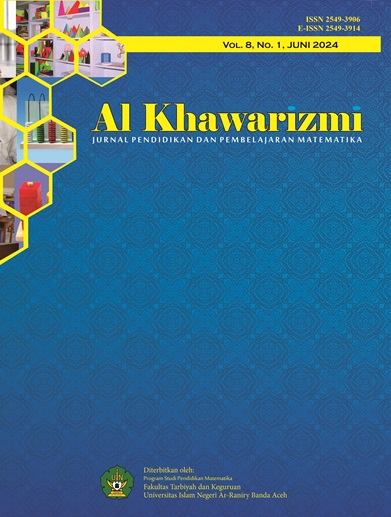Analysis of Junior High School Students' Numeracy Literacy in Solving Minimum Competency Assessment Model (AKM) Questions on Number Content
DOI:
https://doi.org/10.22373/jppm.v8i2.24456Keywords:
Numeracy Literacy, AKM Model Questions, Number ContentAbstract
This research aims to describe and analyze the numeracy literacy abilities of junior high school students in solving AKM model questions on number content. The type of research used in this research is descriptive qualitative research. The research subjects studied were 36 students in class VII-G of SMP Negeri 7 Serang City who had received material on whole numbers and fractions. The research instrument used was the AKM model questions consisting of three descriptive questions which had been adjusted to the numeracy literacy indicators. The written test results were analyzed based on numeracy literacy indicators and then strengthened by the results of student interviews. The research results show that students' numeracy literacy skills in solving AKM model questions on number content are still not good. Because students are unable to meet the three numeracy literacy indicators. Students' numeracy literacy abilities are predominantly in the medium category. In solving AKM model questions on number content, students with high and moderate abilities experienced calculation errors in the results of addition, subtraction, multiplication and division. Students with low abilities have difficulty determining solution strategies and understanding the concept of arithmetic operations of addition, subtraction, multiplication and division on whole numbers and fractions as well as in calculating discounts.
References
Abdussamad, Z. (2021). Qualitative Research Methods (Print I). CV. Syakir Media Press.
Arofa, AN (2022). MA Students' Numeracy Ability in Solving Questions Equivalent to the Minimum Competency Assessment in Algebra Content. MATHEdunesa: Scientific Journal of Mathematics Education, 11(3), 779–793. https://doi.org/10.26740/mathedunesa.v11n3.p779-793
Asrijanty. (2020). AKM and its Implications for Learning. In the Center for Assessment and Learning, Research and Development and Bookkeeping Agency, Ministry of Education and Culture.
Ate, D., & Lede, Y. K. (2022). Analysis of Class VIII Students' Ability in Solving Numeracy Literacy Questions. Scholar's Journal : Journal of Mathematics Education, 6(1), 472–483. https://doi.org/10.31004/cendekia.v6i1.1041
Bala, SS, Zulfikar, RN, & Aba, MM (2023). Types of Errors and Causative Factors in Solving Mathematical Problems with Comparative Material in Class VIIM Muhammadiyah Middle School Students in Kupang. MEGA: Journal of Mathematics Education, 4(2), 652–658. e-journal.unmuhkupang.ac.id/index.php/mega
Brahmansyah, R. (2019). The Influence of Emotional Intelligence and Interest in Learning on Mathematical Problem Solving Ability. Alfarisi: Journal of Mathematics and Natural Sciences Education, 2(3), 282–289. https://doi.org/10.17509/jpak.v4i2.15418
Djamaluddin, A., & Wardana. (2019). Learning And Learning. In CV Kaaffah Learning Center.
Fauziah, A., Sobari, EFD, & Robandi, B. (2021). Analysis of Junior High School (SMP) Teachers' Understanding of the Minimum Competency Assessment (AKM). Educative: Journal of Educational Sciences, 3(4), 1550–1558. https://edukatif.org/index.php/edukatif/article/view/608
Hairunnisa, F., Elvi, M., & Liana, M. (2023). Analysis of Junior High School Students' Mathematical Literacy in Solving AKM Model Questions on Geometry Content. Buana Mathematics: Scientific Journal of Mathematics and Mathematics Education, 13(1), 23–36. https://doi.org/10.36456/buanamatematics.v13i1.7923
Kaka, AEL, Ate, D., & Making, SRM (2021). Analysis of the Numeracy Literacy Ability of Tambolaka City Middle School N.1 Students. Sumba Mathematics Education Research Journal, 3(2), 88–96. https://jurnalstkip-weetebula.ac.id/index.php/jppms/article/view/282
Ministry of Education and Culture. (2023). PISA 2022 and Learning Recovery in Indonesia. Ministry of Education, Culture, Research and Technology.
Khoirunnisa, S., & Adirakasiwi, AG (2023). Analysis of Numeracy Literacy Abilities of Middle School Students in the Era of Independent Learning. Journal of Innovative Mathematics Learning, 6(3), 925–936. https://doi.org/10.22460/jpmi.v6i3.17393
Lestari, RD, & Effendi, KNS (2022). Analysis of Junior High School Students' Mathematical Literacy Ability on Flat Building Material. Biomatics: Scientific Journal of the Faculty of Teacher Training and Education, 8(1), 63–73. https://doi.org/10.35569/biormatics.v8i1.1221
Murtiyasa, B., & Wulandari, V. (2020). Analysis of Student Errors on Fractional Numbers Based on Newman's Theory. AKSIOMA: Journal of the Mathematics Education Study Program, 9(3), 713–726. https://doi.org/10.24127/ajpm.v9i3.2795
Nur, AA, Inayah, ini, Paundria Nagari, G., Setiawan, K., Anisah, N., & Indraprasta PGRI, U. (2022). Numeracy Literacy Ability to Develop Understanding of Concepts in Mathematics Learning. Association: Scientific Journal of Mathematics Education Students, 2(2), 106–113.
Patri, SFD, & Heswari, S. (2022). Analysis of the Numeracy Ability of Class VIII Middle School Students in Sungai Full City in Solving AKM Questions. Estuary Journal, 7(2), 232–237.
Prafitriani, S., Umanailo, MCB, Indrayani, N., Lisaholit, S., & Chamidah, D. (2022). The Influence of Emotional Intelligence on Mathematics Learning Outcomes of Class VII Students at SMP Negeri 9 Buru. Berajah Journal, 2(2), 315–320. https://doi.org/10.47353/bj.v2i2.95
Rahma P, FL, & Reflina. (2023). Analysis of Numeracy Literacy Ability in Solving Program for International Student Assessment (PISA) Questions. Journal of Mathematics Education Works, 10(1), 11–20. https://doi.org/10.26714/jkpm.10.1.2023.11-20
Rezky, M., Hidayanto, E., & Parta, IN (2022). Students' Numeracy Literacy Ability in Solving Socio-Cultural Context Questions on Geometry Topics at Middle School Level. AKSIOMA: Journal of Mathematics Education Study Program, 11(2), 1548. https://doi.org/https://doi.org/10.24127/ajpm.v11i2.4879
Sari, FA, & Aini, IN (2022). Analysis of Numeracy Literacy of Middle School Students in Solving Number Pattern Problems. Tambusai Educational Journal, 6(2), 11963–11969.
Setya, D., & Purnomo, H. (2023). Analysis of Numeracy Literacy Ability of Grade 5 Students at Tamansari State Elementary School 1. MIDA: Journal of Islamic Basic Education, 6(2), 216–227.
Silvia, R., & Asdarina, O. (2024). Students' Numeracy Ability in Fraction Operation Material with the Implementation of the Problem Based Learning (Pbl) Model. EMTEKA: Journal of Mathematics Education, 5(1), 62–72. https://doi.org/10.24127/emteka.v5i1.5516
Susanto, D., Sihombing, S., Radjawane, MM, & Wardani, AK (2021). Learning Inspiration that Strengthens Numeracy. In Ministry of Education and Culture (Vol. 1, Issue 1). https://repository.kemdikbud.go.id/22996/1/Book 1 - Middle School Mathematics Numeracy Module - 23 July 2021.pdf
Tobondo, YV (2015). Description of the Mathematical Literacy Ability of Class VIII B Students at Kalam Kudus Christian Middle School, Surakarta, Academic Year 2014/2015. Sanata Dharma University.
Utari, DR, Wardana, MYS, & Damayani, AT (2023). Analysis of Mathematics Learning Difficulties in Solving Story Problems. Journal of Basic Education Flobamorata, 4(1), 421–423. https://doi.org/10.51494/jpdf.v4i1.845

